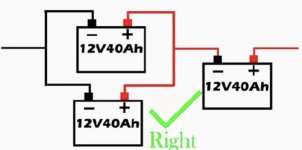slaphappygamer said:
A coulumb meter is what I got. I saw you recommend the circular version.
? I don't remember a circular version, but I guess if it was long enough ago I might not.

But pretty much any of them, assuming they're made correctly, and calibratable to the shunt used on them, will do a good enough job for guesstimations, which is all that's really needed most of the time.
I saw 6.8 amps at max throttle with no load. I'll see what it is under load this weekend.
That's a pretty high no-load current for such a small motor/controller. I'd expect something closer to an amp or two at most, probably less for what you've got.
Is there some physical drag on the system?
Another possibility is that the meter is not calibrated to it's shunt. I glanced thru the linked page but didn't see anything about doing that. Hopefuly it comes with a paper manual that shows how to change the shunt resistance setting in the meter, and the shunt is marked with it's tested resistance.
Also, if you have the high-current version of the meter, it will generally be less able to precisely measure smaller currents. The lower current version is more likely to be able to read smaller currents.
Thanks for the translation link, the internet is a really big area and I never knew that this even existed. That'll come in handy, bookmarked!

THere are also apps for android and ios that let you use the device camera to do live translations, but they dont' help much with webpages (unless you point it at a screen of another device showing the page, not as easy as directly doing it with that linked page).
I'm realizing that I am wasting my time collecting cells that I'll never use. They were used in modems. Modems that are being replaced by a new generation.
THere've been some threads about ex-modem cells to build a pack from. I don't recall the results, but the cells would be pretty low-capability, current-wise, almost certainly sacrificing that for capacity (as they wouldnt' need high currents to run a modem).
These threads turned up in a quick search
https://endless-sphere.com/forums/viewtopic.php?f=2&t=104471
https://endless-sphere.com/forums/viewtopic.php?f=14&t=96528
but not sure there's much useful actual results there.
So I'll find a way to install the coulumb meter on the handlebars. I didn't even know they existed until i read a post of yours.
FWIW, if you ever go looking for a different one, you'll see them more commonly called wattmeters though that's not all that they do, and coulomb meter is just as applicable. Some examples of RC-style wattmeters
https://www.google.com/search?q=rc+wattmeter&tbm=isch
more widely varied results, most of which aren't usable for ebikes/scooters
https://www.amazon.com/s?k=wattmeter&ref=nb_sb_noss
.
I've been reading some of those threads about scooter conversions. I was trying to find out more about removing the sprocket on the motor to know if I can maybe change to a chain.
Keep in mind a chain will probably be noisier, especially with the tiny sprockets usually used on these motors.
If the belt works fine and doesn't cause you problems, and you can get sprockets of the right size on whichever end you need to change for torque/speed, and a belt of the right length, then there's not really a reason to change to chain.
(my motto in experimenting has often been "if it's not broken, upgrade it till it is", but that is more fun than helpful....)



